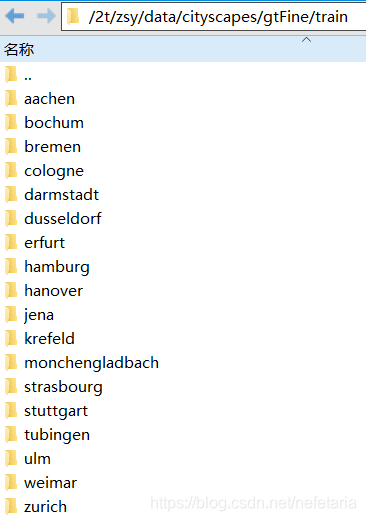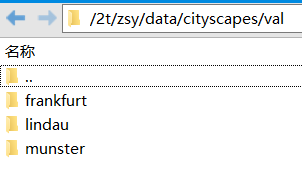cityscapesScripts是cityscapes数据集的官方公开工具集,第一次用的时候有点迷茫,记录下使用笔记,前边是readme里的讲解,以下是精细标注的部分
官方github:
https://github.com/mcordts/cityscapesScripts/tree/master/cityscapesscripts
Readme.md 翻译:
https://blog.csdn.net/Cxiazaiyu/article/details/81866173
数据集链接:
www.cityscapes-dataset.net
百度云下载:https://pan.baidu.com/s/16jj6FLG_cp3paJVjCWAJ_A 提取码:4je2 里面不包含19998 images的
Coarse
粗略注释 # 百度网盘已更新 @20201015
参考:
https://blog.csdn.net/zz2230633069/article/details/84591532
https://blog.csdn.net/Cxiazaiyu/article/details/81866173
1 cityscapes数据集结构Dataset Structure

文件夹结构如下:
{root}/{type}{video}/{split}/{city}/{city}_{seq:0>6}_{frame:0>6}_{type}{ext}各个元素的意义:
-
root
Cityscapes数据集的根文件夹。 我们的许多脚本检查指向该文件夹的环境变量“CITYSCAPES_DATASET”是否存在,并将其作为默认目录。 -
type
数据类型或形态,比如
gtFine
代表精细的GroundTruth,
leftImg8bit
代表左侧相机的八位图像。 -
split
分割,即train, val, test, train_extra或demoVideo。 请注意,并非所有分组都存在所有类型的数据。 因此,偶尔找到空文件夹不要感到惊讶。 -
city
所属城市 -
seq
序列号,使用6位数字。 -
frame
帧号,使用6位数字。 请注意,在一些城市中,虽然记录了非常长的序列,但在一些城市记录了许多短序列,其中仅记录了第19帧 -
ext
该文件的扩展名和可选的后缀,例如,
_polygons.json
为GroundTruth文件
type的类型
:
-
gtFine
精细注释,2975张训练图,500张验证图和1525张测试图。 这种类型的注释用于验证,测试和可选的训练。 注解使用包含单个多边形的“json”文件进行编码。 另外,我们提供
png
图像,其中像素值对标签进行编码。 有关详细信息,请参阅
helpers / labels.py
和
prepare
中的脚本 -
gtCoarse
粗略注释,可用于所有训练和验证图像以及另一组19998张训练图像(
train_extra
)。 这些注释可以用于训练,也可以与
gtFine
一起使用,也可以在弱监督的环境中单独使用。 -
gtBboxCityPersons
行人边界框注释,可用于所有训练和验证图像。 有关更多详细信息,请参阅helpers / labels_cityPersons.py以及
CityPersons
出版物(Zhang等,CVPR’17)
-
leftImg8bit
左侧图像,采用8位LDR格式。这些图像都有标准的注释. -
leftImg8bit_blurred
the left images in 8-bit LDR format with faces and license plates blurred. Please compute results on the original images but use the blurred ones for visualization. We thank
Mapillary
for blurring the images. -
leftImg16bit
左侧图像,采用16位HDR格式。这些图像提供每像素16位色彩深度并包含更多信息,特别是在场景的非常黑暗或明亮的部分。 警告:图像存储为16位PNG,这是非标准的,并且不是所有库都支持。 -
rightImg8bit
右侧图像,采用8位LDR格式。 -
rightImg16bit
右侧图像,采用16位HDR格式。 -
timestamp
记录时间,单位是ns。 每个序列的第一帧总是有一个0的时间戳。 -
disparity
预先计算的视差深度图。 为了获得视差值,对于p> 0的每个像素p计算:d =(float(p)-1)/ 256,而值p = 0是无效测量。 警告:图像存储为16位PNG,这是非标准的,并且不是所有库都支持。 -
camera
内部和外部相机校准。 有关详情,请参阅
csCalibration.pdf
-
vehicle
车辆测距,GPS坐标和室外温度。 详情请参阅
csCalibration.pdf
split的类型
:
-
train
通常用于训练, 包含 2975 张带有粗糙或精细标注的图像 -
val
应该用于验证hyper-parameters,包含500个具有精细和粗糙注释的图像。 也可以用于训练. -
test
用于在我们的评估服务器上测试。 注释不公开,但为方便起见,我们包含自我车辆和整改边界的注释。 -
train_extra
可以选择性地用于训练,包含带有粗略注释的19998张图像 -
demoVideo
可用于定性评估的视频序列,这些视频不提供注释
2 Scripts
cityscapes scripts公开以下工具:
-
csDownload
: 命令行下载cityscapes包 -
csViewer
: 查看图像并覆盖批注(overlay the annotations)。 -
csLabelTool
: 标注工具. -
csEvalPixelLevelSemanticLabeling
: Evaluate pixel-level semantic labeling results on the validation set. This tool is also used to evaluate the results on the test set.像素级评估 -
csEvalInstanceLevelSemanticLabeling
: Evaluate instance-level semantic labeling results on the validation set. This tool is also used to evaluate the results on the test set.实例级评估 -
csEvalPanopticSemanticLabeling
: Evaluate panoptic segmentation results on the validation set. This tool is also used to evaluate the results on the test set.全景分割评估 -
csCreateTrainIdLabelImgs
: Convert annotations in polygonal format to png images with label IDs, where pixels encode “train IDs” that you can define in
labels.py
.将多边形格式的注释转换为带标签ID的png图像,其中像素编码“序列ID”,可以在labels.py中定义。 -
csCreateTrainIdInstanceImgs
: Convert annotations in polygonal format to png images with instance IDs, where pixels encode instance IDs composed of “train IDs”.将多边形格式的注释转换为具有实例ID的png图像,其中像素对由“序列ID”组成的实例ID进行编码。 -
csCreatePanopticImgs
: Convert annotations in standard png format to
COCO panoptic segmentation format
.将标准png格式的注释转换为COCO全景分割格式。
cityscapes scripts文件夹
文件夹内容如下:
-
helpers
: 被其他脚本文件调用的帮助文件 -
viewer
: 用于查看图像和标注的脚本 -
preparation
: 用于将GroundTruth注释转换为适合您的方法的格式的脚本 -
evaluation
: 评价你的方法的脚本 -
annotation
: 被用来标注数据集的标注工具 -
download
: 下载Cityscapes packages
请注意,所有文件顶部都有一个小型documentation。 非常重要
-
helpers/labels.py
: 定义所有语义类ID的中心文件,并提供各种类属性之间的映射。 -
helpers/labels_cityPersons.py
: 文件定义所有CityPersons行人类的ID并提供各种类属性之间的映射。 -
viewer/cityscapesViewer.py
查看图像并覆盖注释。 -
preparation/createTrainIdLabelImgs.py
将多边形格式的注释转换为带有标签ID的png图像,其中像素编码可以在“labels.py”中定义的“训练ID”。 -
preparation/createTrainIdInstanceImgs.py
将多边形格式的注释转换为带有实例ID的png图像,其中像素编码由“train ID”组成的实例ID。 -
evaluation/evalPixelLevelSemanticLabeling.py
该脚本来评估验证集上的像素级语义标签结果。该脚本还用于评估测试集的结果。 -
evaluation/evalInstanceLevelSemanticLabeling.py
该脚本来评估验证集上的实例级语义标签结果。该脚本还用于评估测试集的结果。 -
setup.py
运行
setup.py build_ext --inplace
启用cython插件以进行更快速的评估。仅针对Ubuntu进行了测试。
3 安装
脚本可以通过 pip安装,如下:
sudo pip install如果需要安装的图形工具:
sudo apt install python-tk python-qt4
4 Evaluation
一旦您想在测试集上测试您的方法,请在提供的测试图像上运行您的方法并提交您的结果:www.cityscapes-dataset.net/submit/对于语义标记,我们要求结果格式与我们名为labelIDs的标签图像的格式匹配。因此,代码应该生成图像,其中每个像素的值对应于labels.py中定义的类ID。请注意,我们的评估脚本包含在scripts文件夹中,可用于在验证集上测试您的方法。有关提交过程的详细信息,请访问我们的网站。
参考:
https://blog.csdn.net/Cxiazaiyu/article/details/81866173
通过cityscapesscritps/evaluation/evalPixelLevelSemanticLabeling.py可以比较groudtruth和神经网络预测的结果图像,计算出classes IoU和Categories IoU.
但是这个代码要求输入的是labelIds,所以要求把根据TrainIds预测的图像转化为34类的Id,不方便。我修改的代码可以直接输入_gtFine_labelTrainIds.png和按照trainIds生成的图片;另外由于输入图像的分辨率高2048*1024,实际神经网络输出的分辨率可能不同,代码中修改resize的参数,可以评估修改了分辨率的预测图像。程序下载链接:
https://download.csdn.net/download/cxiazaiyu/10637603
。
5 精细标注训练集
训练使用的label的图片应该是值为0~n的单通道的灰度图,其中n表示类别。cityscapesScripts/helpers/labels.py文件中定义了不同类别和Id值的对应方式、class和category的对应关系等。训练时可以选择自己感兴趣的类别进行训练,如labels.py中给的trainId的19类的例子,不感兴趣的类别trainId设为255,ignoreInEval改为True。
使用训练数据的两种方法: 运行cityscapesscripts/preparation/createTrainIdLabelImgs.py代码,会调用labels.py中的类别定义,从json文件中生成19类的用于训练的_gtFine_labelTrainIds.png,进而进行训练。使用_gtFine_labelIds.png的数据,在load时通过代码将不需要的类对应的值设为255(ignore),并建立class_map将训练使用的类依次映射到0~18的连续值。
train集总共有2975张png格式的大小为2048 x 1024的0-255的RGB图片,按照城市名称,有18个文件夹对应德国的16个城市,法国一个城市和瑞士一个城市:


图片命名规则
城市名称_6位数字_6位数字_leftImg8bit.png
例:
aachen:aachen_000000_000019_
leftImg8bit.png,第二部分从000000到000173对应174张图片,第三部分固定是000019
文件夹内容:每张图片对应6个文件,分别存放不同的内容


6 验证集
val集总共有500张png格式的大小为2048 x 1024的0-255的RGB图片,按照城市名称,有3个文件夹对应德国的3个城市


7 测试集
test集总共有1525张png格式的大小为2048 x 1024的0-255的RGB图片,按照城市名称,有6个文件夹对应德国的6个城市


8 测试结果提交
前提:
有注册的账号

其中最后一项要求,上传的结果为labelID,而非trainID,在官方的脚本工程里有对二者的解释:
https://github.com/mcordts/cityscapesScripts/blob/master/cityscapesscripts/helpers/labels.py
#--------------------------------------------------------------------------------
# Definitions
#--------------------------------------------------------------------------------
# a label and all meta information
Label = namedtuple( 'Label' , [
'name' , # The identifier of this label, e.g. 'car', 'person', ... .
# We use them to uniquely name a class
'id' , # An integer ID that is associated with this label.
# The IDs are used to represent the label in ground truth images
# An ID of -1 means that this label does not have an ID and thus
# is ignored when creating ground truth images (e.g. license plate).
# Do not modify these IDs, since exactly these IDs are expected by the
# evaluation server.
'trainId' , # Feel free to modify these IDs as suitable for your method. Then create
# ground truth images with train IDs, using the tools provided in the
# 'preparation' folder. However, make sure to validate or submit results
# to our evaluation server using the regular IDs above!
# For trainIds, multiple labels might have the same ID. Then, these labels
# are mapped to the same class in the ground truth images. For the inverse
# mapping, we use the label that is defined first in the list below.
# For example, mapping all void-type classes to the same ID in training,
# might make sense for some approaches.
# Max value is 255!
'category' , # The name of the category that this label belongs to
'categoryId' , # The ID of this category. Used to create ground truth images
# on category level.
'hasInstances', # Whether this label distinguishes between single instances or not
'ignoreInEval', # Whether pixels having this class as ground truth label are ignored
# during evaluations or not
'color' , # The color of this label
] )
#--------------------------------------------------------------------------------
# A list of all labels
#--------------------------------------------------------------------------------
# Please adapt the train IDs as appropriate for your approach.
# Note that you might want to ignore labels with ID 255 during training.
# Further note that the current train IDs are only a suggestion. You can use whatever you like.
# Make sure to provide your results using the original IDs and not the training IDs.
# Note that many IDs are ignored in evaluation and thus you never need to predict these!
labels = [
# name id trainId category catId hasInstances ignoreInEval color
Label( 'unlabeled' , 0 , 255 , 'void' , 0 , False , True , ( 0, 0, 0) ),
Label( 'ego vehicle' , 1 , 255 , 'void' , 0 , False , True , ( 0, 0, 0) ),
Label( 'rectification border' , 2 , 255 , 'void' , 0 , False , True , ( 0, 0, 0) ),
Label( 'out of roi' , 3 , 255 , 'void' , 0 , False , True , ( 0, 0, 0) ),
Label( 'static' , 4 , 255 , 'void' , 0 , False , True , ( 0, 0, 0) ),
Label( 'dynamic' , 5 , 255 , 'void' , 0 , False , True , (111, 74, 0) ),
Label( 'ground' , 6 , 255 , 'void' , 0 , False , True , ( 81, 0, 81) ),
Label( 'road' , 7 , 0 , 'flat' , 1 , False , False , (128, 64,128) ),
Label( 'sidewalk' , 8 , 1 , 'flat' , 1 , False , False , (244, 35,232) ),
Label( 'parking' , 9 , 255 , 'flat' , 1 , False , True , (250,170,160) ),
Label( 'rail track' , 10 , 255 , 'flat' , 1 , False , True , (230,150,140) ),
Label( 'building' , 11 , 2 , 'construction' , 2 , False , False , ( 70, 70, 70) ),
Label( 'wall' , 12 , 3 , 'construction' , 2 , False , False , (102,102,156) ),
Label( 'fence' , 13 , 4 , 'construction' , 2 , False , False , (190,153,153) ),
Label( 'guard rail' , 14 , 255 , 'construction' , 2 , False , True , (180,165,180) ),
Label( 'bridge' , 15 , 255 , 'construction' , 2 , False , True , (150,100,100) ),
Label( 'tunnel' , 16 , 255 , 'construction' , 2 , False , True , (150,120, 90) ),
Label( 'pole' , 17 , 5 , 'object' , 3 , False , False , (153,153,153) ),
Label( 'polegroup' , 18 , 255 , 'object' , 3 , False , True , (153,153,153) ),
Label( 'traffic light' , 19 , 6 , 'object' , 3 , False , False , (250,170, 30) ),
Label( 'traffic sign' , 20 , 7 , 'object' , 3 , False , False , (220,220, 0) ),
Label( 'vegetation' , 21 , 8 , 'nature' , 4 , False , False , (107,142, 35) ),
Label( 'terrain' , 22 , 9 , 'nature' , 4 , False , False , (152,251,152) ),
Label( 'sky' , 23 , 10 , 'sky' , 5 , False , False , ( 70,130,180) ),
Label( 'person' , 24 , 11 , 'human' , 6 , True , False , (220, 20, 60) ),
Label( 'rider' , 25 , 12 , 'human' , 6 , True , False , (255, 0, 0) ),
Label( 'car' , 26 , 13 , 'vehicle' , 7 , True , False , ( 0, 0,142) ),
Label( 'truck' , 27 , 14 , 'vehicle' , 7 , True , False , ( 0, 0, 70) ),
Label( 'bus' , 28 , 15 , 'vehicle' , 7 , True , False , ( 0, 60,100) ),
Label( 'caravan' , 29 , 255 , 'vehicle' , 7 , True , True , ( 0, 0, 90) ),
Label( 'trailer' , 30 , 255 , 'vehicle' , 7 , True , True , ( 0, 0,110) ),
Label( 'train' , 31 , 16 , 'vehicle' , 7 , True , False , ( 0, 80,100) ),
Label( 'motorcycle' , 32 , 17 , 'vehicle' , 7 , True , False , ( 0, 0,230) ),
Label( 'bicycle' , 33 , 18 , 'vehicle' , 7 , True , False , (119, 11, 32) ),
Label( 'license plate' , -1 , -1 , 'vehicle' , 7 , False , True , ( 0, 0,142) ),
]
其中的id就是labelID,是按照cityscapes支持的所有类别顺序进行标注的。trainID是需要目标任务(比如语义分割)需要的类别,不需要的类别设为255。最终结果需要用labelID标注。
Make sure to provide your results using the original IDs and not the training IDs
. 比如car的labelID是26,trainID是13。
如果train阶段使用trainID进行训练,test结果转换成labelID即可:
From:
https://github.com/mcordts/cityscapesScripts/blob/master/cityscapesscripts/helpers/labels.py
# Map from trainID to label
trainId = 0
name = trainId2label[trainId].name
print("Name of label with trainID '{id}': {name}".format( id=trainId, name=name ))也可以train阶段就转换成labelID进行训练,test结果不需要进行转换。